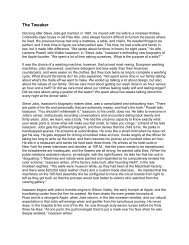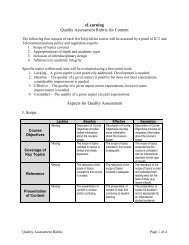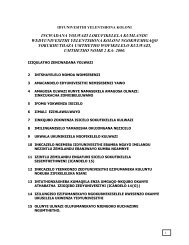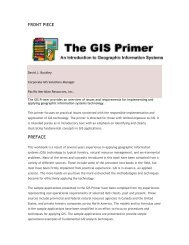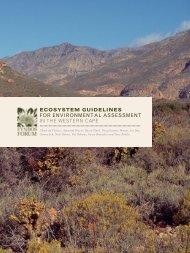Chapter 1 - University of the Western Cape
Chapter 1 - University of the Western Cape
Chapter 1 - University of the Western Cape
You also want an ePaper? Increase the reach of your titles
YUMPU automatically turns print PDFs into web optimized ePapers that Google loves.
<strong>Chapter</strong> 1<br />
The International Tourism Industry:<br />
Opportunities and Threats for Biodiversity Conservation<br />
1.1 The Growth <strong>of</strong> <strong>the</strong> International<br />
Tourism Industry<br />
Since <strong>the</strong> Second World War, <strong>the</strong><br />
growth <strong>of</strong> international tourism has<br />
been phenomenal. Annual tourist<br />
arrivals worldwide increased from<br />
25 million in 1950 to 450 million<br />
in 1990. Between 1969 and 1979,<br />
<strong>the</strong> World Bank encouraged developing<br />
countries to invest in tourism<br />
as a strategy for attracting foreign<br />
investment, and <strong>the</strong> governments <strong>of</strong><br />
developing countries began to see<br />
tourism as a means to redistribute<br />
resources from North to South.<br />
In <strong>the</strong> words <strong>of</strong> <strong>the</strong> World<br />
Tourism Organization (WTO),<br />
tourism became “one <strong>of</strong> <strong>the</strong> most<br />
important economic, social, cultural<br />
and political phenomena <strong>of</strong><br />
<strong>the</strong> twentieth century” (Ceballos-<br />
Lascurain 1996).<br />
Box 1: The World’s Biggest Industry?<br />
Today tourism is <strong>of</strong>ten described<br />
as <strong>the</strong> world’s “biggest” industry<br />
on <strong>the</strong> basis <strong>of</strong> its contribution<br />
to global gross domestic product<br />
(GDP), <strong>the</strong> number <strong>of</strong> jobs it generates,<br />
and <strong>the</strong> number <strong>of</strong> clients it<br />
serves (see Box 1). However, <strong>the</strong>se<br />
conclusions are based largely on<br />
arrivals statistics, which focus on<br />
international tourism and <strong>the</strong>refore<br />
hide <strong>the</strong> significance <strong>of</strong> domestic<br />
tourism. ese statistics may also<br />
underestimate regional tourists<br />
traveling by land ra<strong>the</strong>r than air<br />
or sea. e WTO estimates that<br />
<strong>the</strong> ratio <strong>of</strong> domestic to international<br />
tourism is as high as 10:<br />
1—although this varies hugely<br />
from country to country (WTO<br />
1997). e size <strong>of</strong> <strong>the</strong> industry<br />
and its rate <strong>of</strong> growth present both<br />
opportunities and threats for biodiversity<br />
conservation.<br />
Statistics produced by <strong>the</strong> World Travel and Tourism Council (WTTC) indicate that tourism<br />
generates 11 percent <strong>of</strong> global GDP, 3 employs 200 million people, and transports nearly<br />
700 million international travelers per year—a figure that is expected to double by 2020.<br />
According to <strong>the</strong> World Tourism Organization, international tourism<br />
• accounts for 36 percent <strong>of</strong> trade in commercial services in advanced economies and<br />
66 percent in developing economies;<br />
• constitutes 3–10 percent <strong>of</strong> GDP in advanced economies and up to 40 percent in<br />
developing economies;<br />
• generated US$464 billion in tourism receipts in 2001;<br />
• Is one <strong>of</strong> <strong>the</strong> top five exports for 83 percent <strong>of</strong> countries and <strong>the</strong> main source <strong>of</strong><br />
foreign currency for at least 38 percent <strong>of</strong> countries.<br />
Above: Walking tour through <strong>the</strong> rural villages <strong>of</strong><br />
Tuscany, Italy.<br />
Left: A wild cheetah adapts to <strong>the</strong> presence <strong>of</strong><br />
tourists by using a vehicle as a hunting lookout in<br />
Kenya’s Maasai Mara Game Reserve.<br />
“<br />
The tourism industry was<br />
considered by some to be a<br />
more reliable source <strong>of</strong> foreign<br />
exchange than minerals, raw<br />
materials, cash crops and<br />
manufactured goods, which had<br />
increasingly unstable prices.<br />
Tourism was also seen as an<br />
exceptional opportunity to valorize<br />
national culture, wildlife and<br />
”<br />
unique natural features.<br />
(Ghimire 1997).<br />
TOURISM AND BIODIVERSITY: MAPPING TOURISM’S GLOBAL FOOTPRINT<br />
1





